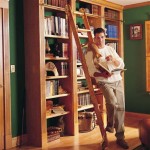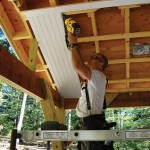A Guide to Wooden Ceiling Panels
Wooden ceiling panels offer a compelling combination of aesthetic appeal and practical benefits for interior design. These panels can transform a space, adding warmth, texture, and a touch of sophistication that other materials often struggle to achieve. This guide examines the various aspects of wooden ceiling panels, covering their types, advantages, installation considerations, and maintenance requirements.
Types of Wooden Ceiling Panels
The market offers a diverse array of wooden ceiling panels, each with unique characteristics and applications. Understanding these differences is crucial for selecting the most appropriate panel type for a given project.
Solid Wood Panels: Solid wood panels are crafted from single pieces of timber, showcasing the natural beauty and grain patterns of the wood. These panels are typically more expensive than other options but offer exceptional durability and a luxurious feel. Common wood species used for solid wood panels include oak, maple, cherry, and walnut. Each species imparts a distinct color and grain character to the finished product. Installation of solid wood panels often requires specialized skills due to their weight and potential for expansion and contraction with changes in humidity. Furthermore, sourcing wood from sustainable forests is essential to mitigate environmental impact.
Engineered Wood Panels: Engineered wood panels are manufactured by bonding layers of wood veneer or fibers together using adhesives. This construction method offers several advantages over solid wood, including increased stability, reduced susceptibility to warping and cracking, and often a lower cost. Popular types of engineered wood panels include plywood, medium-density fiberboard (MDF), and particleboard. Each type possesses differing levels of strength and moisture resistance. Plywood is known for its strength and layered construction, while MDF provides a smooth surface ideal for painting or laminating. Particleboard is a more budget-friendly option but may not be suitable for high-moisture environments. The selection of the appropriate engineered wood panel depends on the specific application and desired aesthetic.
Wood Veneer Panels: Wood veneer panels consist of a thin layer of real wood veneer adhered to a substrate such as plywood or MDF. This approach allows for the application of expensive or rare wood species without the high cost of solid wood. The veneer is carefully selected and applied to create a seamless and visually appealing surface. Wood veneer panels offer a balance between aesthetics and affordability, making them a popular choice for residential and commercial projects. The quality of the veneer and the substrate are critical factors in determining the overall durability and longevity of the panel.
Acoustic Wood Panels: Acoustic wood panels are designed to improve the sound quality within a space by absorbing or diffusing sound waves. These panels typically incorporate perforations or grooves that enhance their acoustic performance. They are often used in theaters, conference rooms, and music studios to reduce reverberation and improve speech intelligibility. Acoustic wood panels can be made from solid wood, engineered wood, or a combination of materials. The design and configuration of the perforations or grooves are critical factors in determining the panel's acoustic effectiveness. Some acoustic panels also incorporate sound-absorbing materials such as mineral wool or fiberglass, further enhancing their performance.
Advantages of Wooden Ceiling Panels
Wooden ceiling panels offer a multitude of benefits that contribute to their widespread use in interior design. These advantages extend beyond aesthetics, encompassing practical considerations such as insulation, acoustics, and ease of installation.
Aesthetic Appeal: The natural beauty of wood adds warmth, texture, and character to any space. Wooden ceiling panels can create a rustic, contemporary, or traditional ambiance, depending on the wood species, finish, and panel design. The grain patterns and color variations inherent in wood contribute to a unique and visually appealing aesthetic. Wooden panels can also be stained or painted to achieve a desired color palette, allowing for seamless integration with existing décor. The versatility of wood allows for a wide range of design possibilities, making it a popular choice for architects and designers.
Improved Acoustics: As mentioned earlier, acoustic wood panels can significantly improve the sound quality within a room. These panels absorb or diffuse sound waves, reducing reverberation and echo. This is particularly beneficial in large spaces or rooms with hard surfaces, where sound can easily bounce around, creating a distracting and uncomfortable environment. The use of acoustic wood panels can enhance speech intelligibility and create a more pleasant and functional space for work, entertainment, or relaxation. The effectiveness of acoustic wood panels depends on their design, material composition, and installation method.
Enhanced Insulation: Wood possesses natural insulating properties, which can help to regulate the temperature within a space and reduce energy consumption. Wooden ceiling panels can provide an additional layer of insulation, helping to keep rooms warmer in the winter and cooler in the summer. This can lead to significant savings on heating and cooling costs over time. The insulating properties of wood also contribute to a more comfortable and consistent indoor environment. The effectiveness of wood insulation depends on the thickness and density of the wood, as well as the presence of any air gaps or thermal bridges.
Ease of Installation: Many wooden ceiling panels are designed for easy installation, making them a suitable option for both professional installers and DIY enthusiasts. Various installation methods are available, including tongue-and-groove systems, clip-in systems, and adhesive mounting. The choice of installation method depends on the type of panel, the substrate to which it is being attached, and the desired level of permanence. Careful planning and preparation are essential for a successful installation. This includes ensuring that the substrate is level, clean, and dry. Proper installation techniques can help to prevent problems such as warping, cracking, and loosening of the panels over time.
Durability and Longevity: Wood is a durable material that can withstand years of use with proper care and maintenance. Wooden ceiling panels can resist scratches, dents, and other types of damage, making them a long-lasting investment. The durability of wood depends on the species, quality, and finish. Hardwood species such as oak and maple are more resistant to wear and tear than softwood species such as pine. A protective finish can also help to protect the wood from moisture, UV light, and other environmental factors. Regular cleaning and maintenance can further extend the lifespan of wooden ceiling panels.
Installation Considerations for Wooden Ceiling Panels
Proper installation is crucial for ensuring the long-term performance and aesthetic appeal of wooden ceiling panels. Careful planning and attention to detail are essential to avoid common problems such as warping, cracking, and uneven surfaces.
Substrate Preparation: The substrate to which the wooden ceiling panels are being attached must be level, clean, and dry. Any imperfections in the substrate can telegraph through to the panels, creating an uneven surface. It is also important to ensure that the substrate is strong enough to support the weight of the panels. If the substrate is weak or damaged, it may need to be repaired or reinforced before installation. Proper preparation of the substrate is a critical step in ensuring a successful and long-lasting installation.
Acclimation: Before installation, wooden ceiling panels should be acclimated to the environment in which they will be installed. This involves storing the panels in the room for several days to allow them to adjust to the temperature and humidity levels. This helps to prevent warping or cracking after installation due to changes in moisture content. The acclimation period can vary depending on the type of wood, the climate, and the humidity levels. Following the manufacturer's recommendations for acclimation is essential for optimal results.
Installation Methods: Various installation methods are available for wooden ceiling panels, including tongue-and-groove systems, clip-in systems, and adhesive mounting. The choice of installation method depends on the type of panel, the substrate, and the desired level of permanence. Tongue-and-groove systems provide a seamless and secure connection between panels. Clip-in systems allow for easy removal and replacement of panels. Adhesive mounting is a simple and cost-effective option for smaller panels. Regardless of the chosen method, it is important to follow the manufacturer's instructions carefully and use the appropriate tools and materials.
Ventilation: Proper ventilation is essential for preventing moisture buildup and promoting the longevity of wooden ceiling panels. Adequate ventilation can help to prevent warping, cracking, and the growth of mold or mildew. In areas with high humidity, it may be necessary to install a vapor barrier or a ventilation system. Regular inspection of the ceiling panels can help to identify any signs of moisture damage and allow for timely repairs.
Lighting Considerations: The placement and type of lighting fixtures can significantly impact the overall appearance of wooden ceiling panels. Recessed lighting can highlight the texture and grain patterns of the wood, while pendant lights can add a decorative touch. It is important to consider the color temperature and intensity of the lighting to create the desired ambiance. Proper lighting can enhance the beauty of wooden ceiling panels and create a more inviting and functional space.

Choosing The Right Type Of Wood Rulon International

A Complete Guide To Using Wpc Ceiling Panels

Wood Ceiling Design Ideas 21 Designer Rooms With Ceilings

Wood Ceiling Design Ideas 21 Designer Rooms With Ceilings

A Complete Guide To Using Wpc Ceiling Panels

Beadboard Ceiling Panels Ceilings Armstrong Residential

A Complete Guide To Using Wpc Ceiling Panels

A Complete Guide To Using Wpc Ceiling Panels

A Complete Guide To Using Wpc Ceiling Panels

Guide To Ceilings Materials And Uses In Architectural Projects Archdaily
Related Posts








